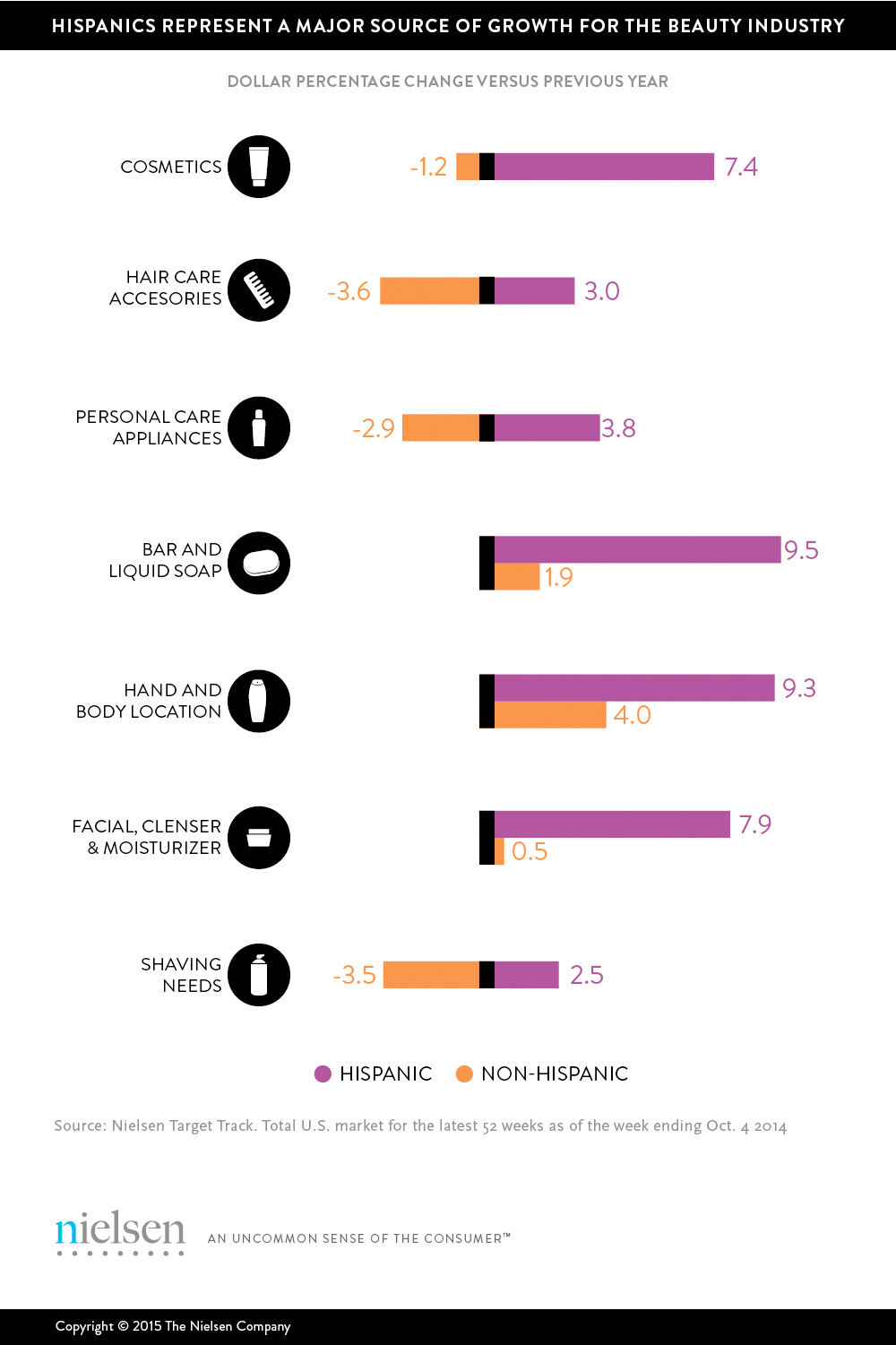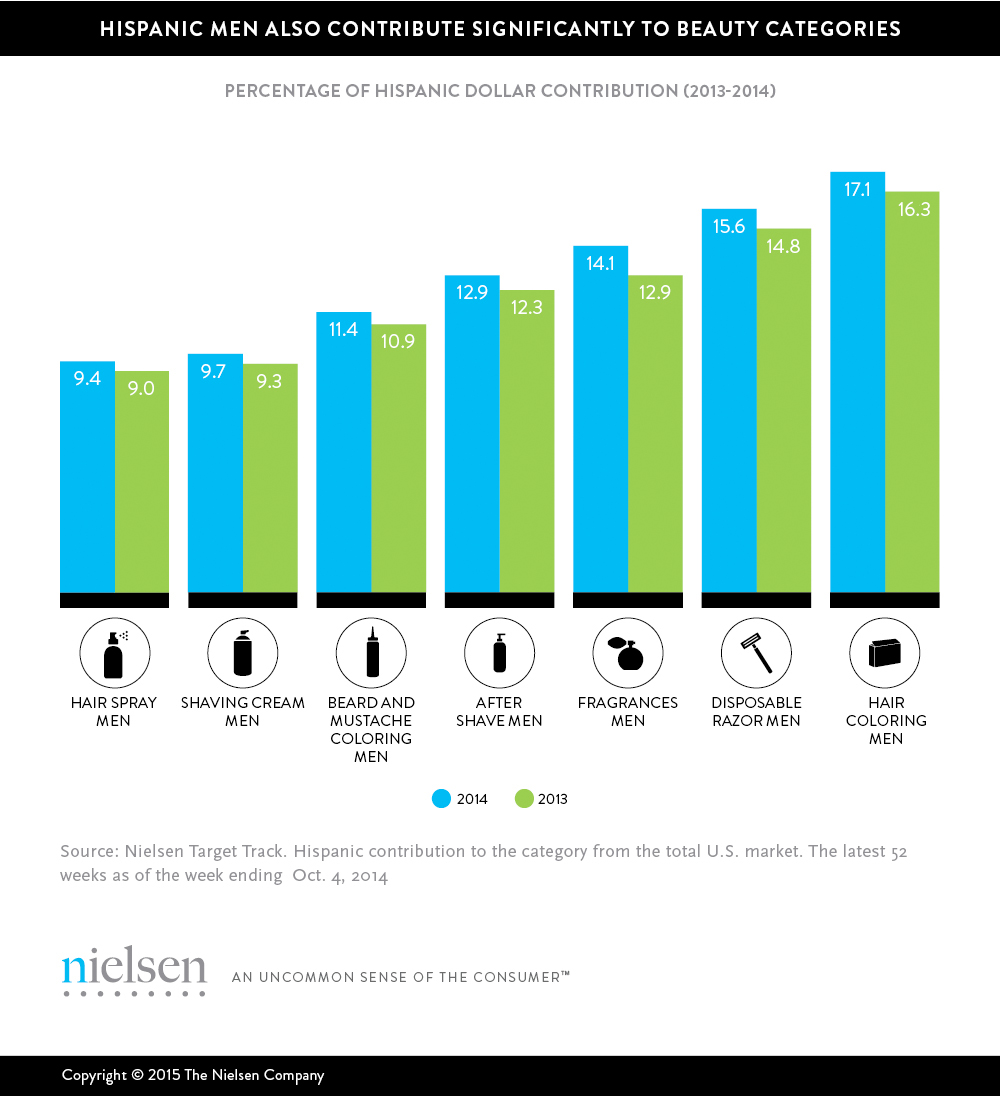Hispanic Consumers are the “Foundation” for Beauty Category Sales
February 26, 2015
![]() Beauty may be in the eye of the beholder as the saying goes, but for many, it doesn’t hurt to have a little help from the beauty aisle. Still, while 94% of U.S. households buy products from this category, consumers consider many beauty products discretionary expenditures.
Beauty may be in the eye of the beholder as the saying goes, but for many, it doesn’t hurt to have a little help from the beauty aisle. Still, while 94% of U.S. households buy products from this category, consumers consider many beauty products discretionary expenditures.
Sales have declined across several beauty categories, including cosmetics, hair care, personal care appliances and shaving needs. However, sales in these same categories grew within Hispanic households. In fact, Hispanic spending in seven key beauty categories grew year-over-year. As a result, Latinos, who represent about 17% of U.S. population, are becoming more important to health care and beauty.

A strong culture of beauty influences Latino consumers’ decisions. Personal appearance is very important for them: They feel valued and grow their self-esteem when they “beautify themselves,” by getting a new hairstyle or wearing fragrances, creams or cosmetics. As a result, Hispanic consumers tend to use personal care products frequently and like to experiment with new products. For example, Hispanics are more likely to spend on hair care products than the general market, and they account for 16% of the total U.S. sales to this category. They also drive 14% of overall fragrances sales and 13% of cosmetics sales, the top two beauty care categories for Hispanic shopper spending.
In fact, half of the top 20 consumer packaged goods categories where Hispanics over-index, or spend more frequently than the general population, are in health and beauty. Latinos also purchase many different products within beauty at higher rates than the total U.S. market.
The Bevvy of Latin Beauties
While many Hispanics in the U.S. share a cultural connection, this group is diverse with subgroups whose characteristics affect their shopping behaviors. So while Hispanics of all origins are outspending non-Hispanics in the beauty aisle, some nuances arise in product and store preferences.
Not surprisingly, for instance, Hispanic women over-index (121) versus total households in terms of cosmetics consumption, representing a huge opportunity for the beauty industry. But Hispanic men, who make up 8.2% of the U.S. population, are not far behind. Latinos are part of a larger trend—total U.S. male spending on beauty products increased 10% in the 12-month period ending June 2014. But like Latinas, Hispanic men also outspend their non-Hispanic counterparts in many beauty categories. Latino men increased their spending in seven key male beauty categories in 2014 from 2013, and beauty categories for men are contributing significantly to the category growth.

Beyond gender, Hispanics’ roots can also play a role in their beauty buying habits. U.S.-born Latinos outspend both foreign-born and non-Hispanics in the category. U.S.-born Hispanics are a strong sub-group in the U.S, representing 64% of total Hispanics. And their higher spending on beauty ties to their higher incomes. Across households, 52% of U.S.-born homes earn at least $50,000 each year, compared with 33% of homes led by foreign-born Hispanics.
These differences in earnings not only affect Hispanics’ spending on beauty but also where they shop. U.S.-born and non-Hispanics have similar retail relationships, both choosing drug channels as their second choice for beauty care purchases. Meanwhile, foreign-born Latinos’ relatively lower incomes may contribute to this group favoring club outlets, which sell bulk goods at discounts, as their second choice for beauty products. (Mass merchandisers were the top shopping destination for beauty products for all Hispanics and non-Hispanics.)
Language can also differentiate Hispanics’ beauty shopping. Spanish-speaking dominant Hispanics typically spend more on beauty care products than English-speaking dominant Latinos. Specifically, Spanish-preferred Hispanic households spend more on hair coloring, hair growth, personal care and disposable diapers than do their English-preferred counterparts. Conversely, English-speaking preferred Hispanics tend to spend more on hair spray and powders for women than do their Spanish-speaking counterparts.
The Art of Reaching Hispanic Beauty Buyers
In the short and long term, Latinos are a very promising business for the industry. They offer an opportunity to increase penetration and per capita spending in three segments: men’s products, baby products and anti-aging products.
Despite differences among Hispanics shopping habits, the group’s attitude toward beauty reflects their high spending within the category. And their mindsets are fairly similar across life stages.
Still, those of different ages have diverse needs—and retailers should vary their approach to each generation. Older generations place greater emphasis on skin care, while younger Latinos are more easily influenced by samples and celebrity endorsements. Younger Hispanics are possibly more likely to buy ‘in the moment’ than older Latinos, so they potentially have higher spontaneous purchasing.
For marketers, this is key: Hispanic beauty consumers are driving category growth, but they are by no means a monolithic demographic. Differences exist between Hispanic consumers of varying ages, genders, incomes and preferred languages spoken at home. The more beauty marketers, manufacturers and retailers take time to understand their Hispanic consumers, the more effective they can become at connecting with them.




























